
The Northrop Radioplane Target DroneIn the late 1930s, the Radioplane Company had developed a series of radio-controlled model airplanes as aerial targets for antiaircraft gunnery training by the Army Air Corps. In 1952, Radioplane Co. became the Radioplane Division of Northrop Aircraft, Inc. Later the Radioplane Division became known as the Ventura Division, Northrop Corporation.
Northrop Radioplane MQM-36 "Shelduck" / KD2R-5http://www.vectorsite.netRadioplane built a series of improved targets, though details are unclear, unsurprising given the obscurity of the subject as well as the multiple and confusing designations applied to each model. The ultimate result of this evolution, the "MQM-36 (originally KD2R-5) Shelduck" gunnery target, is well-known, and in fact remains in service. Design of the Shelduck began in1946, with first flight in 1947. It is larger and more businesslike than the RP-5A, and is powered by a flat-four four-stroke McCulloch piston engine with 95 horsepower. The Shelduck can carry radar enhancement devices on its wingtips. Northrop Radioplane MQM-36 "Shelduck" / KD2R-5:
Wingspan : 3.5 meters : 11 feet 6 inches Over 60,000 Shelducks were built in all, and the type has been used by at least 18 nations internationally.
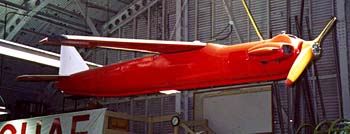 Northrop Radioplane MQM-36 "Shelduck" / KD2R-5 Western Museum of Flight - Click Image to Enlarge
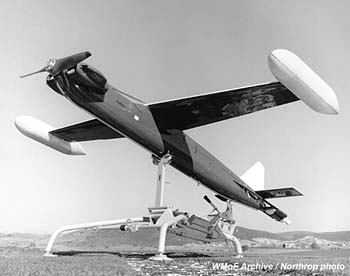 Northrop Radioplane MQM-36 "Shelduck" / KD2R-5 Western Museum of Flight - Click Image to Enlarge
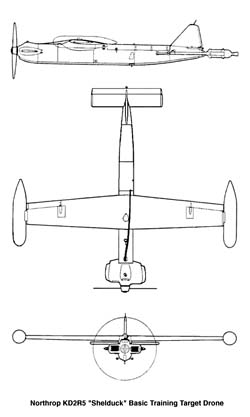 Northrop Radioplane MQM-36 "Shelduck" / KD2R-5 Photo : TBA - Click Image to Enlarge
Northrop Radioplane RP-71 Falconer, SD-1/MQM-57(A/B) A variant of the Shelduck named the Falconer was built for battlefield reconnaissance, with first flight in 1955. The Falconer was similar in appearance to the Shelduck, but had a slightly longer and definitely stockier fuselage. It had an autopilot system with radio-control backup, and could carry cameras, as well as illumination flares for night reconnaissance. Equipment was loaded through a hump in the back between the wings.
_350.jpg) Northrop Radioplane RP-71 Falconer, SD-1/MQM-57(A/B) Photo : TBA - Click Image to Enlarge
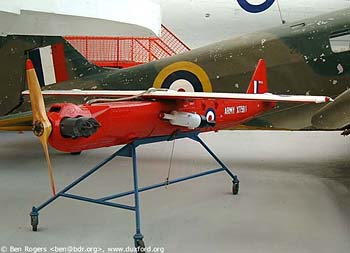 Northrop Radioplane RP-71 Falconer, SD-1/MQM-57(A/B) Photo : http://www.duxford.org - Click Image to Enlarge
Radioplane was bought out by Northrop in 1952 to become the Northrop Ventura Division, though it appears that the "Radioplane" name lingered on for a while. Reginald Denny died in 1967 at age 75, after what sounds like an interesting and profitable dual career in the film and aviation industries.
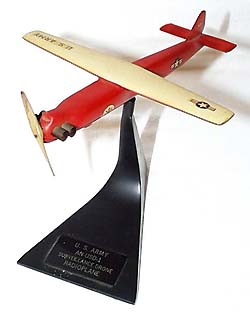 Northrop Radioplane RP-71 Falconer, SD-1/MQM-57(A/B) Photo : eBAY - Click Image to Enlarge
http://www.designation-systems.net which says in part... In 1955, Radioplane developed the Model RP-71 Falconer as a derivative of the OQ-19/MQM-33 series of target drones. The drone was launched by a solid rocket booster from a zero-length launcher, and was recovered by parachute. The RP-71 had onboard still picture (and optional TV) cameras, and was used by the U.S. Army as the surveillance drone of the AN/USD-1 system. The drone itself was either known as AN/USD-1 (although this was really the designation of the whole drone surveillance system, including ground equiopment) or as SD-1 (as an abbreviation of AN/USD-1, with SD conveniently being interpreted as "Surveillance Drone"). Series production of the SD-1 for the U.S. Army started in 1959. In June 1963, the RP-71 drones of the AN/USD-1A and AN/USD-1B surveillance systems were designated as MQM-57A and MQM-57B, respectively. The MQM-57 remained in service until the mid-1970s, and a total of about 1500 MQM-57s of all versions were built by Northrop Ventura (formerly Radioplane).
Northrop Radioplane RP-76 Target Drone Northrop Radioplane RP-76 Target Drone Western Museum of Flight, Hawthorne, California Western Museum of Flight - Click Image to Enlarge
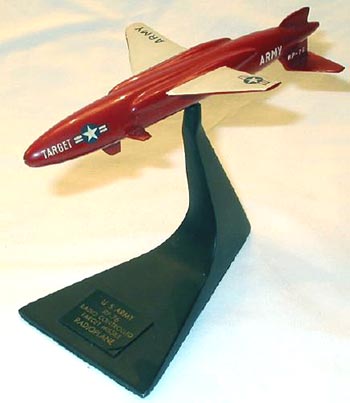 Northrop Radioplane RP-76 Target Drone Photo : TBA - Click Image to Enlarge
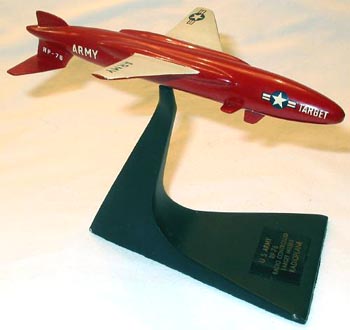 Northrop Radioplane RP-76 Target Drone Photo : TBA - Click Image to Enlarge
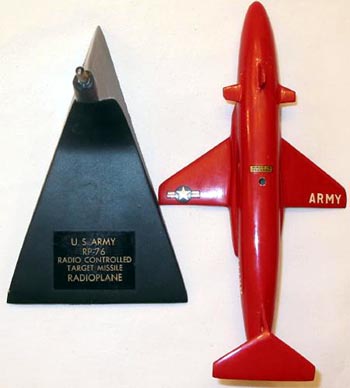 Northrop Radioplane RP-76 Target Drone Photo : TBA - Click Image to Enlarge
The Northrop Radioplane - Advertisments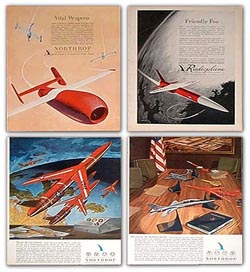 The Northrop Radioplane Photo : TBA - Click Image to Enlarge
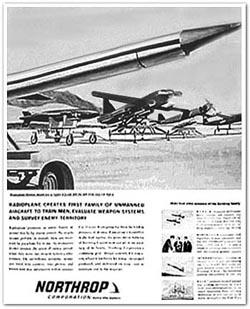 The Northrop Radioplane Photo : TBA - Click Image to Enlarge
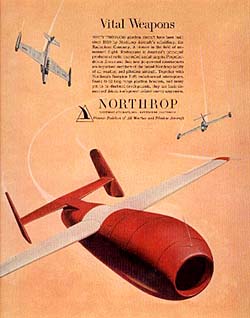 The Northrop Radioplane Photo : TBA - Click Image to Enlarge
Further Reading
List of Naval Aviation Drones and Missiles cached copy made on 301002 for use if main site (above) fails
U.S. Mil. Aircraft and Weapon Designations : Q-Drone Aircraft
U.S. Mil. Aircraft and Weapon Designations : TD-Target Drone Aircraft
Pre-1963 Designations Of U.S. Missiles And Drones
and from this site selected 'Radioplane' Data... 2.6 Army, 1955 - 1963 In June 1955, the Army stopped using the 1947/1951 system. Until the introduction of the joint system in 1963, Army missiles were designated (like any other Army equipment) with "Ordnance Numbers" only. These numbers are usually assigned as soon as a new equipment enters the Army inventory. I will only give a brief synopsis of this designation system here. For details, look at the description of the current Army Nomenclature System. 3.1 Navy, 1942 - 1946 In 1942, the Navy introduced the TD designation for target drones into its aircraft designation system.
In March 1946, the Navy included missiles and drones in its aircraft designation scheme and introduced the K class with the type designation KD for drones. Existing TD drones were redesignated. Drone conversions of manned aircraft received normal aircraft designations with a K suffix. The latter designations are not listed below. A single TD drone was redesignated in the short-lived U (for "Unmanned") category.
In 1940, the Army Air Force introduced an "A for Aerial Targets" category in its aircraft designation scheme. This evidently duplicated the "A for Attack" category and was replaced in June 1941 by the following categories, with existing "A" models being redesignated:
1. Some sources attribute the OQ-1 designation to the Radioplane RP-4 drone. However, OQ-1 is not listed in the Army's 1946 designation listing : US Army Air Forces: Army Aircraft Model Designations, 1946. 2. The designations OQ-8, OQ-9 and OQ-10 were probably not skipped. However, the "official" source [obit] only says "No data available". 3.4 Air Force, 1947 - 1963 The Air Force introduced the Q category for drones in 1947. Existing PQ models were redesignated. While no new OQ-numbers were assigned, existing OQ drones retained their designations (but see notes below).
1. John M. Andrade: U.S. Military Aircraft Designations and Serials 1909-1979, Midland, 1979 says, the OQ models were redesignated Q on paper (but designations not actually used). Therefore, the Q-3 would be identical to the OQ-3. James C. Fahey: United States Air Force and United States Army Aircraft 1947-1956 and Norman J. Bowman: The Handbook of Rockets and Guided Missiles, Perastadion Press, 1963, however, describe the Q-3 as a Q-1 version. 2. It's not quite clear, whether OQ-7 and OQ-11 were actually redesignated as Q-7 and Q-11, or whether the Q-7/11 numbers were skipped, because OQ-7/11 were still in use.
|
© Copyright 1999-2005 CTIE - All Rights Reserved - Caution |